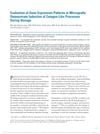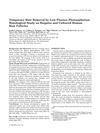Search
forLearn
5 / 11 resultslearn Osteopontin
signaling protein that, when suppressed, may grow hair by reducing inflammation and stem cell loss
learn Thymosin Beta 4
learn Epidermal Growth Factor
learn Stem Cell Factor
Research
5 / 1000+ results
research Evaluation of Gene Expression Patterns in Micrografts Demonstrates Induction of Catagen-Like Processes During Storage
Storing hair follicle micrografts for longer times can cause them to enter a state similar to the natural hair shedding phase, which might impact hair transplant results.
research Human Hair Growth In Vitro: A Model for the Study of Hair Follicle Biology
Human hair growth can be influenced by certain growth factors and has specific metabolic needs.
research Methods in Hair Research: How to Objectively Distinguish Between Anagen and Catagen in Human Hair Follicle Organ Culture
A reliable system was developed to distinguish hair growth stages, aiding in identifying hair growth promoters or inhibitors.

research Temporary Hair Removal by Low Fluence Photoepilation: Histological Study on Biopsies and Cultured Human Hair Follicles
Low fluence photoepilation temporarily removes hair by targeting the hair follicle's pigmented area without severe damage.
research Analysis of Apoptotic Cell Death in Human Hair Follicles In Vivo and In Vitro
Apoptosis in hair follicles varies by growth phase, with TGF-β possibly starting the catagen phase.
Community Join
5 / 55 resultscommunity Tretinoin for some men(not all) can cause non-telogen effluvium hair loss
Tretinoin can cause non-telogen hair loss in some men by inducing catagen-like changes in hair follicles and through retinoid toxicity, especially when used with minoxidil. Some users report hair loss even when using retinoids on the face, while others experience benefits when combined with treatments like finasteride and minoxidil.
community Fevipiprant 2019!
The conversation discusses Fevipiprant, an asthma drug that may block CRTH2 and potentially stop male pattern baldness (MPB) without inhibiting DHT. It also mentions the use of finasteride and dutasteride for hair loss.
community A concise, easy-to-understand post on Androgenic Alopecia theory and its practical applications
The mechanism of Androgenic Alopecia and practical applications of treatments like Minoxidil, Finasteride, RU58841, dermarolling, scalp massages, anti-fungals, progesterone, estrogen, PPAR-γ activators, reducing oxidative stress, and scalp exercises. It explains why DHT is important in AA and how other factors might be involved such as hypoxia, increased DKK-1 expression, morphological changes to the scalp, skull growth during childhood/puberty, and blood flow.
community PP405: The Ultimate Hair Loss Drug for Complete Hair Growth
PP405 is a new hair loss treatment in phase 2 trials that may promote hair growth by increasing lactate production and activating hair follicle stem cells. It could potentially replace hormone-disrupting treatments like Minoxidil and finasteride.
community Weed/THC effects on hair growth/hair loss, and vitality of organ-culture human follicle studies (research review)
Cannabis and THC may have mixed effects on hair, with some studies suggesting potential negative impacts on hair growth in isolated hair follicles, but these results are hard to apply to living humans. Treatments like minoxidil and finasteride are commonly used for hair loss, and the effects of cannabis might be neutral or vary based on individual factors.